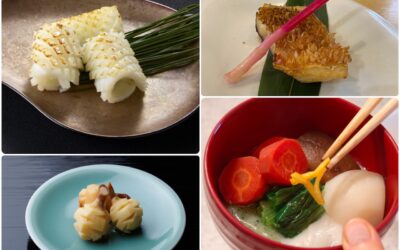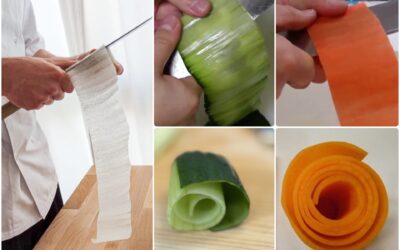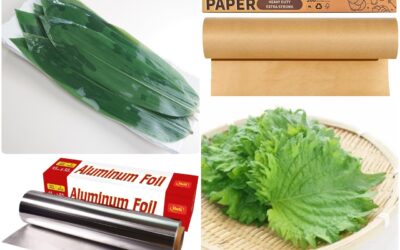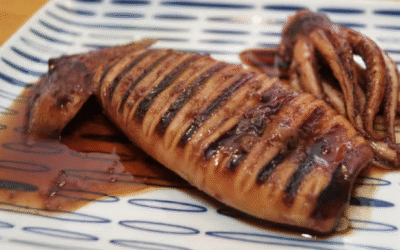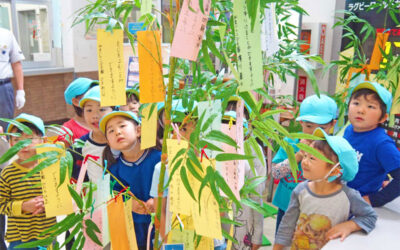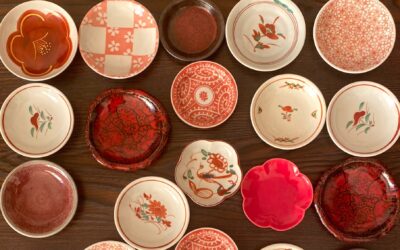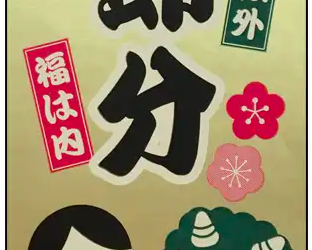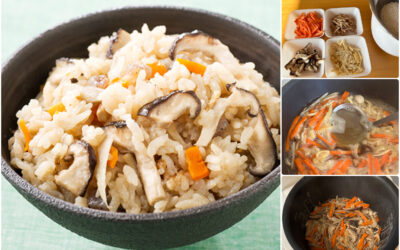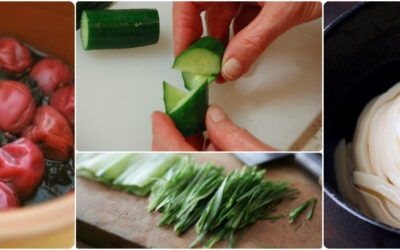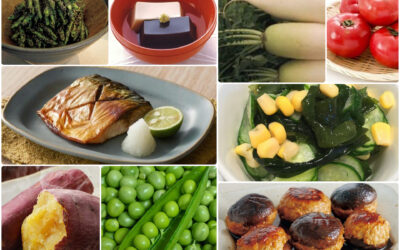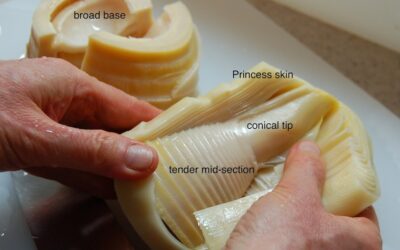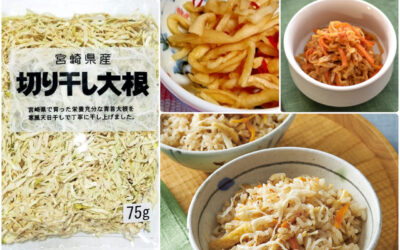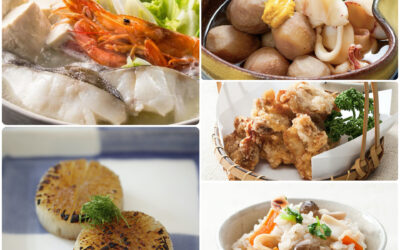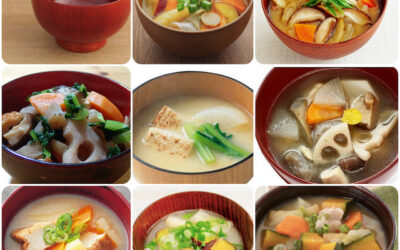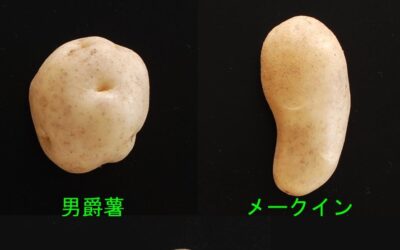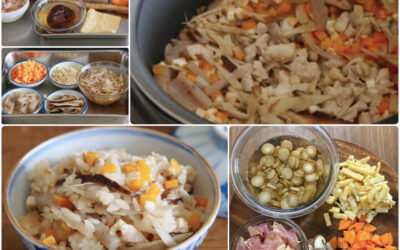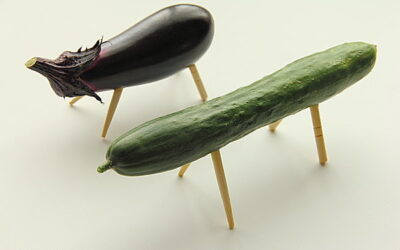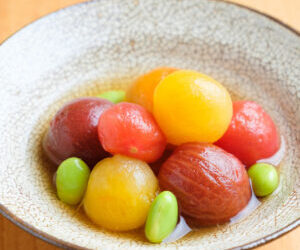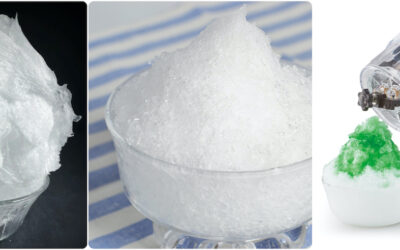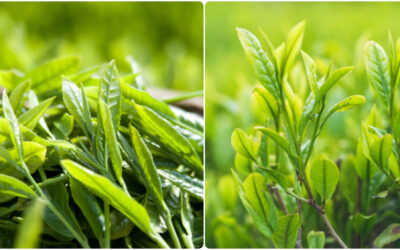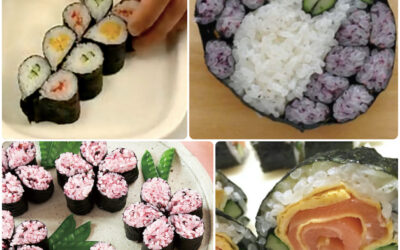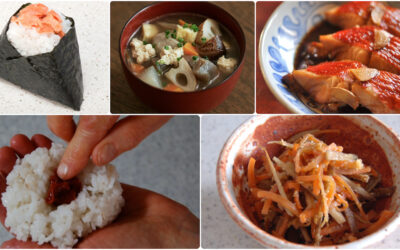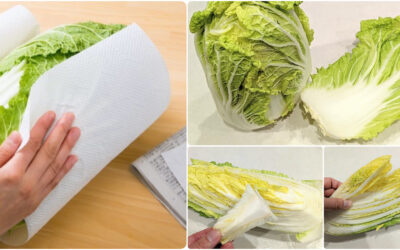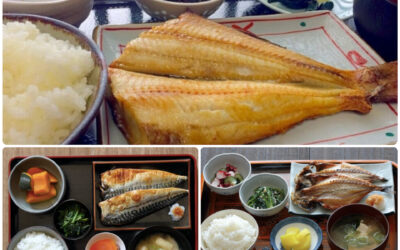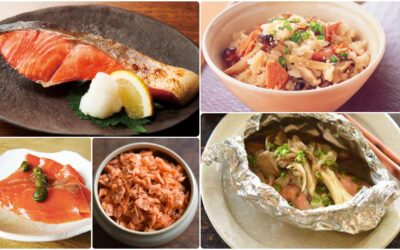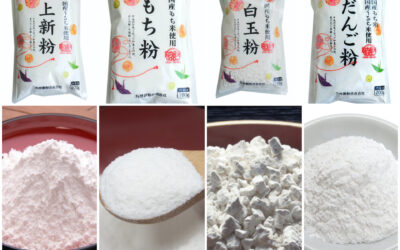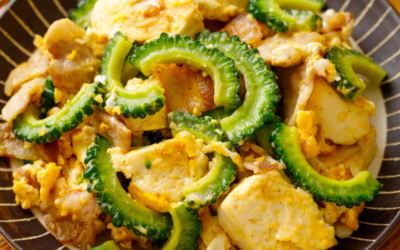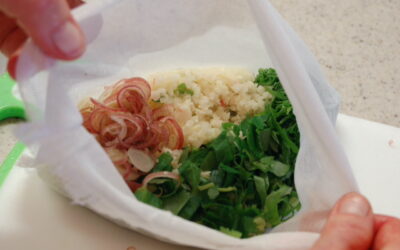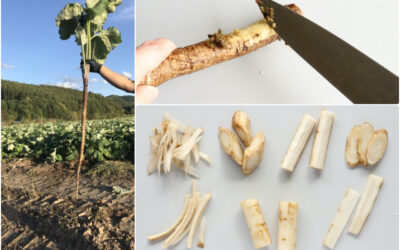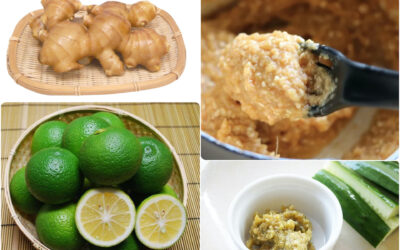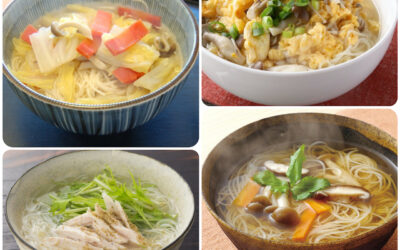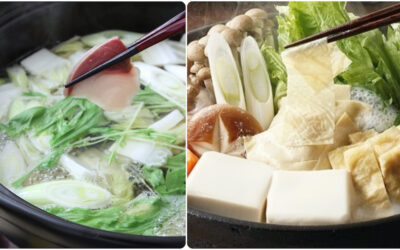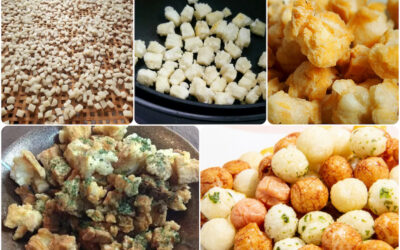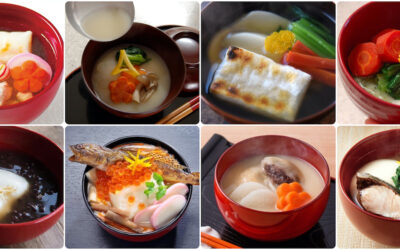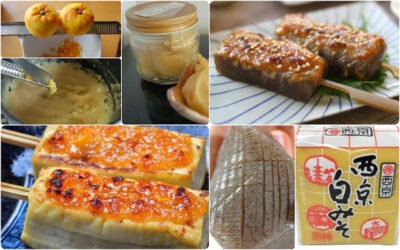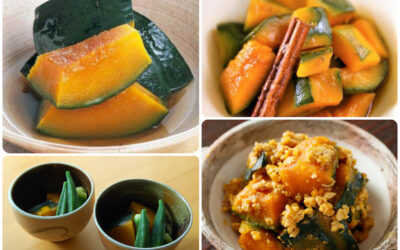Kitchen Projects
EXPLORE and PRACTICE Japanese cooking in your own kitchen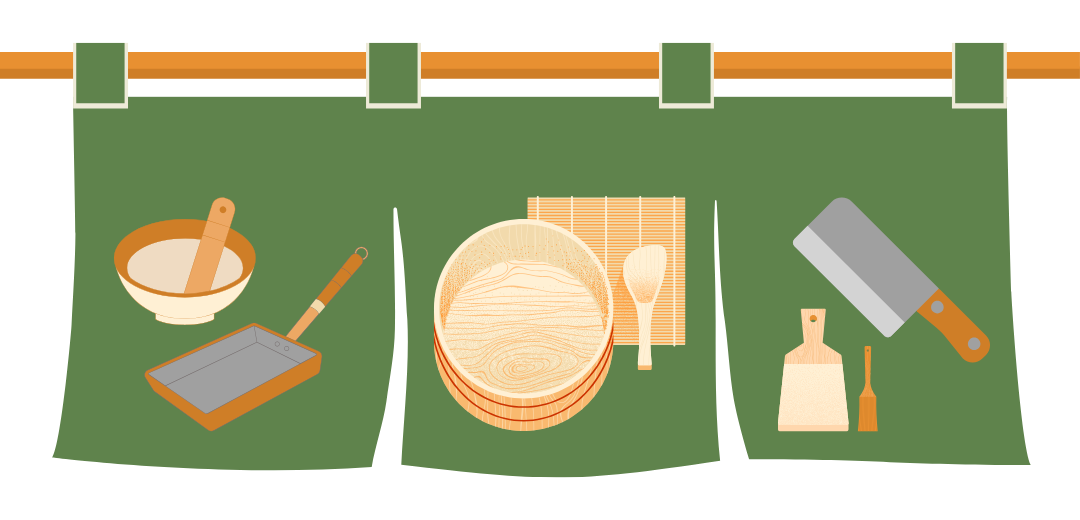
Kitchen PROJECTS are an opportunity for everyone to explore and practice Japan’s kitchen wisdom in their own kitchens. The projects are self-paced and can be started (or paused) at any point.
Each time you access this page, six projects will be displayed at random in a rotating slider. Click on what captures your interest. You can also search or scroll through the entire list below (there are of dozens of projects to choose from) and select what appeals to you.
Enjoy!
All the Projects
PROJECT Symbolic Pine
Because pine trees are hardy evergreens, they are a symbol of longevity and resilience in Japanese culture. As such they are a key motif used at New Year’s. Various foods are configured to resemble pine. Cones (matsukasa) and needles (matsuba) are the most frequently...
PROJECT Katsura Muki
This PROJECT is about learning to make katsura muki, a classic cutting technique in the traditional Japanese kitchen. When done properly, long, flowing, continuous and incredibly thin peels are produced from vegetables such as daikon radish, cucumbers and carrots. In...
PROJECT Tsutsumu
Wrapped foods are varied. Sometimes parchment or foil is used to enclose foods before they are cooked. Other times the wrappers are edible making pop-in-your-mouth savory packets. Below, two examples for you to try in your kitchen. Enjoy!包み蒸し Archaeological evidence...
PROJECT Crunchy, Spicy Cucumbers
The catergory of foods known as tsukémono runs the gamut from sokuseki ("impatient") and asazuké (lightly pickled) to furuzuké (literally "old" or overly pickled) foods that are intensely-flavored and/or deeply fermented. There are dozens of kinds of cucumber...
PROJECT: Ika Yaki
Gingery griddle-seared squid, IKA YAKI イカ焼き is a favorite summer festival food sold thoughout Japan at yatai food stalls. Visit the Summer Festival Food: YATAI post for more information about summer festivals and the food sold at yatai stalls. This Kitchen PROJECT is...
PROJECT: Celebrating Tanabata
The Tale of TANABATA 七夕伝説 The Tale of Tanabata, which originated in China, has been told in Japan for at least 1200 years. The Japanese version tells the story of a cowherd (Kengyū in some versions, Hikoboshi in others, as the star Altair), and the Weaving Princess...
PROJECT Small Plates
MAMÉ-ZARA FunCollecting and Using Small Plates Part of the fun of collecting dishes and other tabletop accessories, is to assemble wide-ranging variations within a category. With mamé-zara, one way to do this is focus on a color scheme such as red and then collect as...
PROJECT Springtime Sweets
洋菓子・yōgashiWestern-Style Confectionery Japan's food culture includes ingredients, techniques and dishes that have been adopted and/or adapted from non-Japanese sources. One large category is confectionery. Earliest influences were from the Portuguese in the 16th...
PROJECT Temari Sushi
This KITCHEN PROJECT features temari-zushi, bite-sized spheres of tart rice topped with various ingredients. HINA MATSURI is celebrated on March 3 and during the weeks leading up to it, and for several weeks thereafter, scattered chirashi-zushi and/or temari-zushi ...
PROJECT Bean-Throwing for Setsubun
Mamé maki (bean-throwing for Setsubun) tosses ogres outside (with dried beans) and brings good fortune inside (with dried beans). Fuku mamé (dry-roasted “good luck” soybeans) can be black or white (beige, really). FUKU wa UCHI ONI wa SOTO Bring in...
PROJECT Noodle-Slurping
NOODLE-SLURPING Anyone who has ever spent time in Japan, or regularly eats at Japanese restaurants, knows (all too well) the sound of slurping. Noodles, for sure, but soup, tea and other liquids, too. Although noodles, soup and beverages are part of every food...
PROJECT Kayaku Gohan
Vegetables cooked into RiceKayaku (Takikomi) Gohan加薬 (炊き込み) ご飯 In different parts of Japan, rice that is cooked in a flavored liquid with a variety of ingredients (that went to flavoring that liquid) goes by various names. The most generic is takikomi because it...
PROJECT Serving Chawan Mushi
This PROJECT is about serving chawan mushi, a dish that requires heatproof cups to cook the egg custards in and to bring them piping hot to table. Because Japan's food culture places importance on the presentation of food, often specialized tableware is chosen....
PROJECT Setting the Autumn Table
This PROJECT is about setting the table... to set the stage for autumn's culinary pleasures. One simple and fun way to do this is by choosing fall-themed HASHI OKI (choptsick rests). Pictured above are a few of the options: autumnal maple leaves, chestnuts, shimeji...
PROJECT Eat to Beat the Heat
This PROJECT is about making foods that are refreshing and restorative when the weather is oppressively hot and humid. Mouth-puckering UMÉBOSHI have long been touted as a way of ensuring food safety on hot days because of their anti-bacterial properties. Members of...
PROJECT Grandchildren are kind
Grandchildren are Kind (mago wa yasashii 孫は優しい) is an acronym that helps Japanese remember the seven food groups that help support a healthy diet. The food groups are: beans (mame), sesame (goma and other seeds and nuts) sea vegetables (wakame), leafy greens and root...
PROJECT Enjoy Junsai
潤菜料理 (junsai ryōri) JUNSAI (water shield; Brasenia schreberi) grows naturally in lakes, ponds and slow streams in many parts of the world but only Japan and China have a long history of cultivating the plant as a food. Young, unfurled sprouts covered in slippery,...
PROJECT Cooking with Early Summer Bounty
初夏の幸の料理 (shoka no sachi no ryōri) The Japanese delight in cooking with seasonal produce and in the early summer that means making delicious dishes with new peas and beans. Using the recipes below as a point of departure, create your own BOUNTY-of-EARLY SUMMER DISH...
PROJECT Cooking with Bamboo Shoots
A single bamboo shoot has different segments, each with a different texture and flavor profile. The BROAD BASE is best suited to cutting into circular slabs, half-moon slices, or chunks. Try slathering these with miso and broiling to make dengaku... or soy-glazing...
PROJECT Kiriboshi Daikon
Cooking with KIRIBOSHI DAIKON in your kitchen. This versatile ingredient can be used in soups, pickles, rice dishes and a variety of sides, too. Here are a few recipes to get you started: Kogane Meshi, a takikomi-style rice dish Granny's Sun-Dried Radish, a...
PROJECT Cooking with Fish Sauce
There are lots of ways of using fish sauce. Here are a few popular examples: (top, left) NABÉMONO (hot pots that get assembled ahead and simmered at table) are often made with a seasoned broth. IKANAGO NABÉ seasoned with funky ikanago shoyu, is brimming with fish,...
PROJECT Miso Soup
In most Japanese households, miso soup is served daily, often as part of breakfast, though it could just as easily appear at lunch or dinner. Most Japanese have strong regional preferences when choosing what miso to use (details posted to Kitchen Culture blog); the...
PROJECT Osechi-Making
December is a busy time… The Japanese aptly call the final month of the year shiwasu, written with calligraphy for "professor" 師 and "running about in a tizzy" 走. In Japan shiwasu is a time of frenzied activity that culminates with Oshogatsu (New Years) when families...
PROJECT Potato
Most white-fleshed potatoes generally fall into either of two categories: fluffy OR waxy. Fluffy potatoes are high-starch and tend to crumble when simmered; they are perfect for mashing, and when making korokke (croquettes). The Japanese often describe these dishes as...
PROJECT Tonburi
Tonburi, the seeds of the broom plant, are tiny and black-green in color. Because they mimic the appearance and mouthfeel of sturgeon caviar tonburi is often referred to as hataké no kyabia (“caviar of the field”). Akita prefecture in the Tohoku produces most of...
PROJECT Takikomi Gohan
Takikomi-style rice dishes are cooked in a flavorful stock extracted from the ingredient being featured (in this case, MUSHROOMS). Takikomi rice is truly a delicious way to enjoy seasonal bounty. Download a recipe for KINOKO GOHAN to get started. It does, however,...
PROJECT Obon
Project OBON is about eggplant and cucumber cookery. Why eggplants and cucumbers? These vegetables reach their peak of flavor during the summer when Obon is celebrated. And, the vegetables are fashioned into transportation for departed spirits. Eager to begin their...
PROJECT Tomato Salad
TOMATOES combine well with both land and sea vegetables, and with cold noodles too, to make a variety of SALADS. This PROJECT Tomato Salad is about creating your own "house" salad featuring tomatoes. To start you off, here is a recipe for enjoying tomatoes...
PROJECT Shaved Ice
PROJECT Shaved Ice is about making Japanese-style kaki-gōri confections.Many people top shaved ice with fresh fruit or commercially prepared syrups. But for those who would like to make their own, here is a simple-to-make STRAWBERRY sauce. Note the recipe includes a...
PROJECT New Tea
This PROJECT is about brewing and enjoying new tea, called shincha 新茶 in Japanese. Shincha teas are available online and in specialty shops around the world. Most of the commercial green tea crop in Japan is grown in Shizuoka, southwest of Tokyo, though Uji (near...
PROJECT Flower-Inspired Rolled Sushi
Use your imagination to create rolled sushi inspired by flowers. To get you started, here are some basic recipes: This recipe for CLASSIC SUSHI MESHI includes instructions on cooking and seasoning rice, and information on the wooden tub in which the cooked rice is...
PROJECT Red Foods and Tableware
Generations of Japanese have been well nourished daily by modest meals following a simple pattern: soup, rice, and a few other dishes. This easy-to-compose menu model called ichi jū san sai (一汁三菜 ) that satisfies hunger while fulfilling nutritional needs. The soup...
PROJECT Naga Negi
Indispensible in nabé (hot pot) cookery, as a condiment and in soups all parts of naga negi (Allium fistulosum) are edible. Plan from the start to use the plant fully. If your naga negi have roots attached, wash them thoroughly to remove all the dirt that clings to...
PROJECT Hakusai
Using HAKUSAI fully A favorite wintertime vegetable in Japan, hakusai cabbages are increasingly available in Asian groceries throughout the world. A whole head averages 2 kilo (about 4 and 1/2 pounds). I encourage you to buy one (or at least a half or quarter-head...
PROJECT Home-Style Meals with Ichiya-boshi
Making a Home-Style Meal featuring ichiya-boshi Traditionally, bountiful catches of fish were gutted, salted, and set out to dry in order to extend their shelf life. The generic term for these sorts of fish is himono, literally “the dried thing,” though these...
PROJECT Adzuki: Sweet & Savory
PROJECT Adzuki: Sweet & Savory The adzuki bean 小豆 plays a prominent role in Japanese cookery, especially in the making of sweets... though savory dishes also abound. This Kitchen PROJECT is about exploring the many possibilities. I provide one sweet recipe for...
PROJECT Salmon
SALMON・鮭・SAKÉ Salmon lends itself to variety of cooking methods -- it can be skillet-seared, steamed, broiled, grilled, braised, smoked, poached and fried. PROJECT Salmon is about preparing salmon in many different ways in your kitchen. You'll find lots of...
PROJECT Rice Flour
米の粉PROJECT: Komé no KonaRice Flour In Japanese cookery there are four types of rice flour that are commonlyused. One is made from uruchi mai or "table rice," several are made from mochi-gomé or "sticky rice" and one is made from a combination of them. The different...
PROJECT Champuru
チャンプルーPROJECT Champuru This Kitchen PROJECT is about making champuru (a stir-fry that is a signature dish of Okinawa) in YOUR kitchen Every household in Okinawa will have its own variation on the basic theme. A classic version made with bacon, tōfu, gōya, onions and...
PROJECT Kampyo
干瓢・かんぴょう・KAMPYŌ This Kitchen PROJECT is about using KAMPYŌ, sun-dried fukubé gourd ribbons in YOUR kitchen. Be sure to source UNBLEACHED (無漂白 mu hyō haku) gourd ribbons so that you can use the softening liquid as a tasty stock. Gourd ribbons are used to tie up any...
PROJECT Yakumi
This Kitchen PROJECT is about making YAKUMI, fresh herb and spice mixtures, in YOUR kitchen.Use yakumi to top dishes such as chilled tōfu, fresh tomatoes or stewed eggplant. Cold noodles served with yakumi to be added to soy-based dips are a Japanese summertime...
PROJECT Cutting and Slicing
PROJECT Cutting & Slicing This Kitchen PROJECT is about cutting & slicing ingredients to maximize flavor, texture and appearance while minimizing waste. Specific examples below focus on gobō cut three different ways: SASAGAKI 笹掻きSENGIRI 千切りRANGIRI 乱切り These...
PROJECT Flavored Miso
PROJECT Flavored Miso This Kitchen PROJECT is about making flavored miso in YOUR kitchen. This page introduces two new flavored miso mixtures, one redolent with fruity kabosu, the other infused with smoky katsuo-bushi flakes. In addition, many recipes for flavored...
PROJECT Kushi (skewers)
PROJECT Kushi This Kitchen PROJECT is about making SKEWERED FOOD in YOUR kitchen. For inspiration and recipes to get you started, use these resources: Black Sesame Miso Tōfu DengakuCrunchy Kushi AgéFuki no Tō Miso Dengaku(Vegan & Vegetarian Options) Oden Part...
PROJECT Chikuzen Ni
筑前煮 ・Chikuzen Ni This Kitchen PROJECT is about making CHIKUZEN NI (soy-braised vegetables in the Fukuoka style) in YOUR kitchen. A cross between a stir-fry and a stew, this dish no doubt has as many variations as there are households in Fukuoka. The BASIC RECIPE I...
PROJECT Nyumen
Above, Four Examples of Nyūmen: Hakusai, Carrot and Shiméji (top left); Egg Drop, Shiméji and Scallions (top right); Chicken and Mitsuba with Sanshō (bottom left); Shiitaké, Shiméji, Carrot and Mitsuba.煮麺 ・Nyūmen This Kitchen PROJECT is about making NYŪMEN (sōmen...
PROJECT Shabu Shabu Nabé
Swished-through-bubbling-broth Buri Shabu Nabé (left) and Shōjin Shabu Nabé (right)しゃぶしゃぶ鍋Shabu Shabu Nabé This Kitchen PROJECT is about making Shabu Shabu Nabé hot-pots in YOUR kitchen. The Japanese have a fondness for naming dishes with onomatopoeia. The name shabu...
PROJECT Rice Snacks
Crisp-and-Crunchy Rice Snacks are a delicious way to use up leftover omochi. Inevitably after the New Years holidays pieces of omochi remain uneaten. Dried and cracking they can be repurposed into tasty ARARÉ. This Kitchen PROJECT is about making crisp-and-crunchy...
PROJECT Ozoni
A sampling of REGIONAL OZŌNI Top row, from left: Kanto (Tokyo area) style, Kansai (Kyoto, Osaka) style, Kanto, KansaiBottom row, from left: Tottori with adzuki-jiru, Miyagi with whole grilled goby fish, Kagawa (Shikoku) with anko-filled mochi, Hakata with buri and...
PROJECT Yuzu Miso
季節のゆず味噌・Kisetsu no Yuzu MisoSeasonal Citrusy Miso Sauce The Japanese delight in bringing elements -- often fresh produce -- of each season to table. Yuzu citrus fruits ripen from green to golden yellow as autumn turns to winter. As yuzu ripen, the peels become...
PROJECT Chrysanthemum
Chrysanthemums ・ 菊 KikuTo eat ... To use as a motif This Kitchen PROJECT is about CHRYSANTHEMUMS, to eat and to use as a motif in designing your autumnal menu. I have created a reference sheet regarding EDIBLE VARIETIES of chrysanthemums. If you can source fresh,...
PROJECT Kabocha
Kabocha, a pumpkin-like squash with sweet, orangey-gold flesh and dark green, edible skin, frequently appears on the menu in Japan. The classic way to prepare kabocha is to simmer it in a slightly sweet soy-tinged stock. Soy-simmered kabocha is delicious on its own…...

